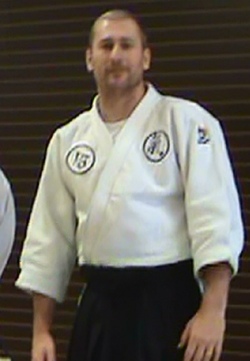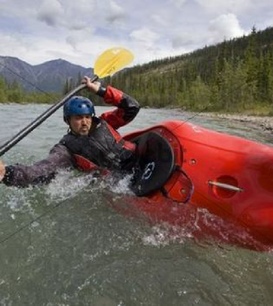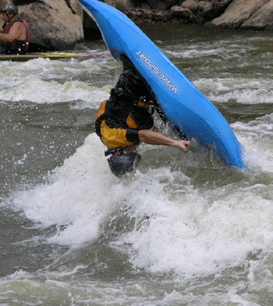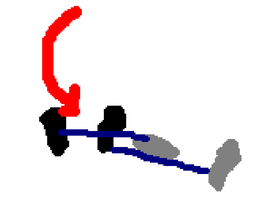


Nage’s Work Station
By Jonathan Wilson
24 May 2015
Earlier this week, I was telling Sensei John Carter that this particular idea of “Nage’s Work Station” has been simmering for years, but did not come to an official head until Sensei Carter made an observation about a problem I was having with a particular Classical Technique. Consider a few Back Stories:
Back Story #1: Kayaking: Yes, White water kayaking. Before my wife and I had kids, we used to do all kinds of cool stuff. I regularly remind my kids, “You know, mom and dad were pretty cool people before you guys came along and ruined it.” ~ Lol (parental humor never seems to get old for me).
Anyway, at one time in my pre-kid era, I fancied myself as a pretty good water water kayaker. White water kayaking is a bit different from white water rafting or paddling a canoe down a river (so if you’ve ever done any of that, don’t feel like you understand what I’m going to say next), because the only thing someone in a canoe and someone in a raft have in common with a white water kayaker is that they are all wearing life jackets.
The aim of white water kayaking (sometimes referred to as “play boating”) is not to “shoot” a rapid (run straight through it as you would in a raft or canoe), but to “stop” and ‘play” in the most dangerous part of the rapid [usually called a “Hole” (hydraulic)] for as long as possible (see picture and youtube videos to the left).
You can play in these holes for days if you wanted because at the point immediately below the hole, the water is flowing back upstream ~~~~ feeding the kayaker back into the hole itself. So if you get kicked out of the hole, you often get sucked right back into it, or if you get blown out, you can still simply paddle over to a nearby eddy, and reenter the hole at your leisure for more play time.
By the way, a hole is where most people who swim in rivers drown, but it is the most exciting place to “play” if you are a white water kayaker. Of course, one of the things you quickly learn is that a 50,000 horse-power washing machine (which is essentially what a hole (river hydraulic) is, takes no prisoners ~~~ even if you are in a boat (see inverted kayaker to the left), so you’ve got to be in a safe position at all times. Regarding safety. If there is a golden rule of paddle placement, it is as follows: “Keep your elbows pinned to your sides if you wish to keep your shoulders attached to your torso.” Keeping your elbows in keeps your paddle in front of you ~ where you are most powerful and stable. While it might look cool to run a rapid with your paddle over your head (and rafters have a great time doing this while saying “Wheeeee”), this action is THE recipe for a dislocated shoulder if you are a kayaker. If your elbow is above your head regularly, the question is not “if” you will dislocate your shoulder kayaking. The question is “when” will you dislocate your shoulder?”
Back Story #2: Last week I was hard at work at my real job (teaching high school kids how to improve their SAT and ACT ~ College Entrance Exam scores). During a break, I asked if any of the students had any experience with martial arts (in preparation to market NGA). One kid had experience in Tae Kwon Do, and some other art whose name I did not recognize. We were on equal ground though, because he had no real understanding of aikido. I hoped to offer a quick, impromptu demonstration, and asked him to grab my wrist with both of his wrists. I had planned to do the First Wrist Technique (Nikyo)~ slowly ~ or the Unbendable Arm (Kokyu nage) slowly as well. That said when he grabbed my wrist, for some reason, he pulled his hands together underneath his center, and locked his elbows to his sides. Even though I outweighed him by 50 pounds and was much stronger than he was, he was stronger than me in this position. Raising my gripped arm was simply not an option, so neither of the two techniques I had planned on using would work at this point. If I wanted to raise my arm, I was going to have to lift his whole body off the floor in the process. Since it was not possible to raise my arm, I lead him down to the floor instead, and then easily established neck control and a Wheel Throw (Kaiten nage) set up... But that’s not the point.
So what is the point of both of these stories? Well, Elbow Positioning is crucial for leveraging your strength. In kayaking, or anything else (like gripping nage), you are strongest when your elbows are at your sides and locked into your center (core), with ki energy extending through your finger tips. The same was true with my Tae Kwon Do demonstration partner. He gripped me very well, and I could not move him in the way I had intended initially.
So how can we apply this idea to our aikido? Well, think about a technique like the Elbow Chop. If your gripped hand elbow separates from your side as you bridge up, lower your weight, and begin step back, will you lose precious lead and power. So you always want to keep that elbow tight to your body ~ with a sense of connection; regardless of what you’re doing.
This idea equally applies to service as uke. A few years ago, I began to experience rear deltoid muscle soreness any time I worked with someone on the Classical Technique of the Whip Throw. After some contemplation, I realized that I was letting my elbow separate from my center so quickly, that when nage rotated his hips and did the throw, the only joint that was not already “locked out” was my shoulder, and it ended up taking 100% of the energy of the throw ~ after a few throws, my shoulder would be so sore, I could barely lift it.
In the past couple of months, I’ve made a conscious attempt to keep a sense of “centeredness and muscular connection” as uke. The result is oddly a more “manageable uke” for nage ~ as uke is never lollygagging or trailing behind the technique, and a safer ukemi experience for me also (so the classic “win-win”).
Here’s another Elbow Connection test (I just thought of, and tried about 5 minutes ago): Hamni Walk across the room. After the turn, instead of “resting” your hands on your hips ~ bring the hands out in front of your body a few inches, and clamp your elbows to your sides as hard as you can. This should energize your core, and you should sense a great deal of ki coming out of your finger tips. If you’re having trouble getting the feeling, it might help to imagine you are hugging something very tightly. Now in this energized posture, execute the same Hamni Walk. This walk should feel much more powerful than the first one, and there should be a powerful and obvious connection between the movement of your hands that is expressly tied to the movement of your hips. At the center is the idea that the secret to strong aikido technique is a strong ki extension from your core, and I wonder if locking your elbows in is a part of that).
Now after that verbose lesson on keeping your elbows at your side, let’s not forget
that there are a significant number of techniques that this notion does not hold
true. Think “Arm Over Shoulder” for example. So is there a universal truth that
perhaps we might “add” to the Elbows at your side to fully tap the idea of “Nage’s
Work Station?
I would suggest that the impetus of suggesting to add a sense of connection
by locking the elbows at your side is another central idea that your hands should
generally be in front of your hips. A few weeks ago, I was working with Sensei Carter
on the Wheel Throw in a 1 on 1 training session. In that session, he noted that
I was leaving my uke a little bit. There was a fraction of a second (just before
establishing head control) that my hands were not in front of my hips, and the tail
hand motion up uke’s back was not timed with my hip rotation. I was rotating my
hips too fast, and leaving that hand behind. This was creating some weakness in
my technique that I was easily fixed by slowing my hip rotation down, allowing my
hands to remain in front of my hips. Adjusting the posture of my thinking to continue
my orientation toward uke throughout the movement was what was missing, and as I
added that during the training session, I knew I had a topic for ngaexperience.com
What say ye?
Want to add to the discussion? Post your comments in the comment box below!

2014 - 2021 ngaexperience.com
Master Nara says, “Elbows and hands in front of your body for maximum strength & power.”


Knee on Belly ~~~ Good enough for Theseus vs the Minotaur, good enough for me, and an excellent follow-up up to many aikido techniques


The BEST way to dislocate your shoulder when kayaking is demonstrated here ~ an ill advised technique known as the “High Brace” (Elbow above head). In any condition other than calm, flat water, this is a sure recipe for shoulder surgery.


Note the position of this kayaker’s elbows (low and in front of the body). A stronger position still would be if his elbows were locked at his side, but this is acceptable and safe. Imagine what type of torque his shoulder would receive if he were to extend the paddle over his head (elbows out and up position) at this point.

This is a video of the “Saluda Boys” (named after the river we paddle near our home). The Boys are a group of guys I used to paddle and hang out with when in the pre-kids era.
You can see great white water/ play boating kayaking technique in this video.
BTW, “Jeff Wilson” (one of the guys featured in this video) is not me.


